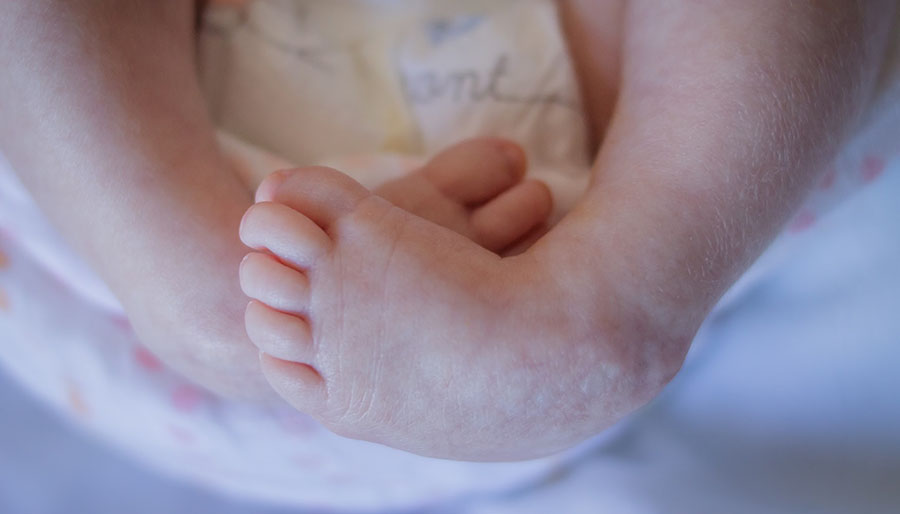Watching 10-month-old Marlowe Emrey crawl and play with her twin sister, Mabel, you would never know Marlowe was born with clubfoot. “Actually, it’s often Mabel who is trying to keep up with Marlowe,” said mom, Angie Emrey.
Clubfoot is the turning in of one or both feet, and can also include stiffness and atrophy in the feet. Untreated clubfoot can cause difficulties with walking and long-term foot problems. It is one of the most common birth defects, affecting one in every 750 to 1,000 live births, but that doesn’t make it easy to accept.
“At our 20-week ultrasound, the doctor noticed both of Marlowe’s feet were turned in. At that point, there was about a 50 percent chance it was clubfoot, so we decided to meet with a pediatric orthopedic specialist at Children’s Wisconsin to learn more. Still, I was kind of wishing it away,” said Angie.
The Ponseti Method
At Children’s Wisconsin, orthopedic specialists use the Ponseti Method, accepted as the gold standard of clubfoot treatment. Starting shortly after birth, when tendons are still flexible, it consists of a series of up to six different castings, changed weekly. Babies then undergo a small procedure done either in the clinic or an operating room.
Prior to the Ponseti method becoming widely accepted after the year 2000, surgical intervention had been the predominant treatment for clubfoot. Now, up to 90 percent of patients can be successfully treated through the less-invasive method, and patients have better outcomes and functionality.
A bit of denial
Still, Angie wasn’t convinced her baby would need the treatment. “When I was still pregnant with the twins, I listened to what our doctor said, but part of me had told myself that Marlowe didn’t have clubfoot and wasn’t going to need this treatment,” said Angie. She didn’t have much time to think about it, however, as the twins arrived 10 weeks early and spent 30 days in a Milwaukee-area NICU.
Following discharge from the NICU, Angie followed up again with Dr. Channing Tassone, MD, pediatric orthopedic specialist at Children’s Wisconsin, when Marlowe was 2 months old. “I was still kind of in denial, so when Dr. Tassone diagnosed Marlowe with clubfoot, I was overwhelmed,” she said. “It was scary thinking about my baby having to go through all those castings.”
Tough diagnosis
Fortunately, Dr. Tassone and Allison Duey-Holtz, pediatric nurse practitioner, were able to help calm Angie’s fears. “I researched clubfoot a lot on the internet,” said Angie, who is convinced that internet medical information is the best and worst thing to happen to parents. “It was hard to sort through everything, and there were some horror stories about treatment out there.”
Her care team at Children’s Wisconsin answered all of her questions and concerns one by one. “They really helped me understand that this is a treatable condition. I went from being devastated, to thinking to myself, ‘It’s just clubfoot, and I’m getting the best care.’”
Successful treatment
Marlowe’s success reinforced Angie’s confidence. “The casting really didn’t seem to faze her, and she slept right through the minor surgical procedure,” said Angie.
Now that most of her treatment is complete, Marlowe wears her “boots and bar,” an apparatus that keeps the feet turned out and prevents recurrence, at nighttime and naptime and will continue to do so until about age 5. She also returns to the orthopedic team for periodic checks to be sure she’s maintaining the amazing changes in her fast-growing feet.
At 10 months, Marlowe is small for her age at 15 pounds, but her mom describes her as “a little pistol.
“She loves to figure out how things work, so we call her our little engineer,” said Angie.
Grateful for Children’s Wisconsin
Angie’s experience was so positive she has offered to be a resource for other parents whose babies are diagnosed with clubfoot. “I understand what it is to feel scared and unsure, but I want people to know this treatment is so good and so effective.
“Before my girls were born, we had always heard people say that you never know how grateful you will be that Children’s Wisconsin is right in your own backyard. Now we understand.”







